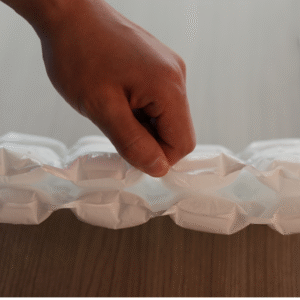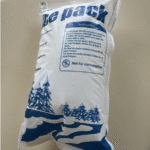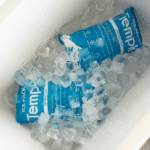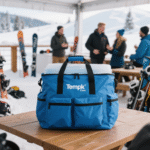Gel Pack vs Dry Ice: Which Cold Chain Solution Is Best for Your Shipment?
Cuando envía productos sensibles a la temperatura, the choice of cooling solution—paquetes de gel o hielo seco—can significantly impact your shipment’s safety, costo, y rendimiento. This article breaks down the key differences between these two options, helping you decide which one is ideal for your cold chain needs in 2025.
-
El control de temperatura capabilities of gel packs and dry ice
-
Cost considerations for both options, including reusability and environmental impact
-
El safety concerns associated with each solution
-
The best scenarios for using gel packs and dry ice in cold chain shipping
Cuáles son Gel Packs and Dry Ice?
Paquetes de gel: An Overview
paquetes de gel are flexible, reusable cooling solutions that contain a non-toxic gel inside a plastic casing. They work by maintaining a moderate temperature, típicamente entre 32°F and 50°F (0°C a 10°C), haciéndolos adecuados para chilled products como la comida, productos cosméticos, and pharmaceuticals that require refrigeration but not freezing.
Hielo seco: An Overview
hielo seco, hecho de dióxido de carbono congelado (CO2), sublimates at -109.3°F (-78.5°C), haciéndolo ideal para frozen products like meat, mariscos, y muestras biológicas. It’s the go-to option when products require extreme low temperatures for long durations.
How Do Gel Packs and Dry Ice Compare?
Rango de temperatura: Which Keeps Your Products Cooler?
-
Hielo seco: Ideal for freezing temperatures, keeping items at sub-zero nivel.
-
Paquetes de gel: Best for moderate cooling, typically maintaining temperatures between 32°F and 50°F (0°C a 10°C).
Duración: How Long Do They Last?
-
Hielo seco: Sublimates over time, generally offering shorter cooling duration unless packed efficiently.
-
Paquetes de gel: Proporcionar más, slower cooling but cannot reach the extreme temperatures that dry ice offers.
Seguridad y manejo: Which Is Safer for Your Team?
-
Paquetes de gel: Safe to touch and handle, with no special equipment needed.
-
Hielo seco: Requires gloves and proper ventilation due to its extreme cold and the potential for CO2 build-up, which can be hazardous in enclosed spaces.
Comparación de costos: Which Is More Budget-Friendly?
| Cooling Solution | Upfront Cost | Reutilizabilidad | Shipping Cost | Overall Cost-Efficiency |
|---|---|---|---|---|
| Paquetes de gel | Más bajo | Reutilizable | Más bajo | Cost-effective for short-term shipments |
| Hielo seco | Más alto | De un solo uso | Más alto | Expensive for long-term shipments |
-
Paquetes de gel are a more solución rentable for businesses looking for short-term cooling without the need for ultra-low temperatures.
-
Hielo seco is typically Más caro upfront and is a one-time-use product, making it more suitable for shipments requiring ultra-low temperatures for long periods.
Preocupaciones de seguridad: Which Is Safer to Handle?
-
Paquetes de gel: Safer for handling, with no toxic emissions or extreme cold risks. They can be safely touched and reused.
-
Hielo seco: Requiere un manejo especial. Congelación can occur upon direct contact, and dry ice can displace oxygen in confined spaces, potentially causing suffocation.
When Should You Use Gel Packs?
paquetes de gel are perfect for:
-
Short-term shipments where temperature control isn’t critical
-
Products that need enfriamiento moderado (p.ej., non-perishable food, productos cosméticos, productos farmaceuticos)
When Is Dry Ice the Best Option?
hielo seco is essential when:
-
Envío comida congelada como la carne, mariscos, o helado
-
Manejo muestras biológicas o productos farmaceuticos that require extreme low temperatures
-
Transporting goods over longer distances or extended shipping durations
Emerging Trends in Cold Chain Shipping: What to Expect in 2025
A medida que evoluciona la industria de la cadena de frío, several innovación are improving the efficiency and sustainability of cooling solutions:
-
Sustainable alternatives: Eco-friendly gel packs and biodegradable packaging are gaining popularity.
-
Advanced monitoring technologies: Real-time temperature monitoring systems powered by IoT ensure better tracking and compliance.
-
Materiales de cambio de fase (PCM): These materials offer consistent temperature control por períodos más largos, becoming a viable alternative to both gel packs and dry ice.
Preguntas frecuentes
Q1: Which solution lasts longer—gel packs or dry ice?
-
Dry ice tends to last longer, especially for ultra-low temperatures, while gel packs are more effective for enfriamiento moderado over a longer period.
Q2: Are gel packs safe for food shipments?
-
Sí, gel packs are safe for shipping food, especially non-perishable items that need to stay cool, Pero no congelado.
Q3: Can I use dry ice for chilled items?
-
Dry ice is not recommended for chilled items as it provides frío extremo. Gel packs are more suitable for keeping items cool without freezing them.
Conclusión y recomendaciones
Elegir entre paquetes de gel y hielo seco depends on the temperature needs of your shipment. paquetes de gel are perfect for moderate cooling and are more rentable for short-term shipments. Sin embargo, hielo seco is necessary for shipments requiring ultra-low temperatures and longer durations. By assessing your product type and shipping conditions, you can make an informed decision.
Actionable Tip: If your business is new to cold chain logistics, start with gel packs for non-frozen products and experiment with dry ice for those requiring extreme cold.
Acerca de Tempk
En Templ, we specialize in providing innovative cold chain solutions for all your shipping needs. Nuestros productos, including gel packs and dry ice, are designed to maintain the integrity of your products durante el tránsito. We prioritize sostenibilidad y rentabilidad in all our solutions.
For expert advice, reach out to us today!























